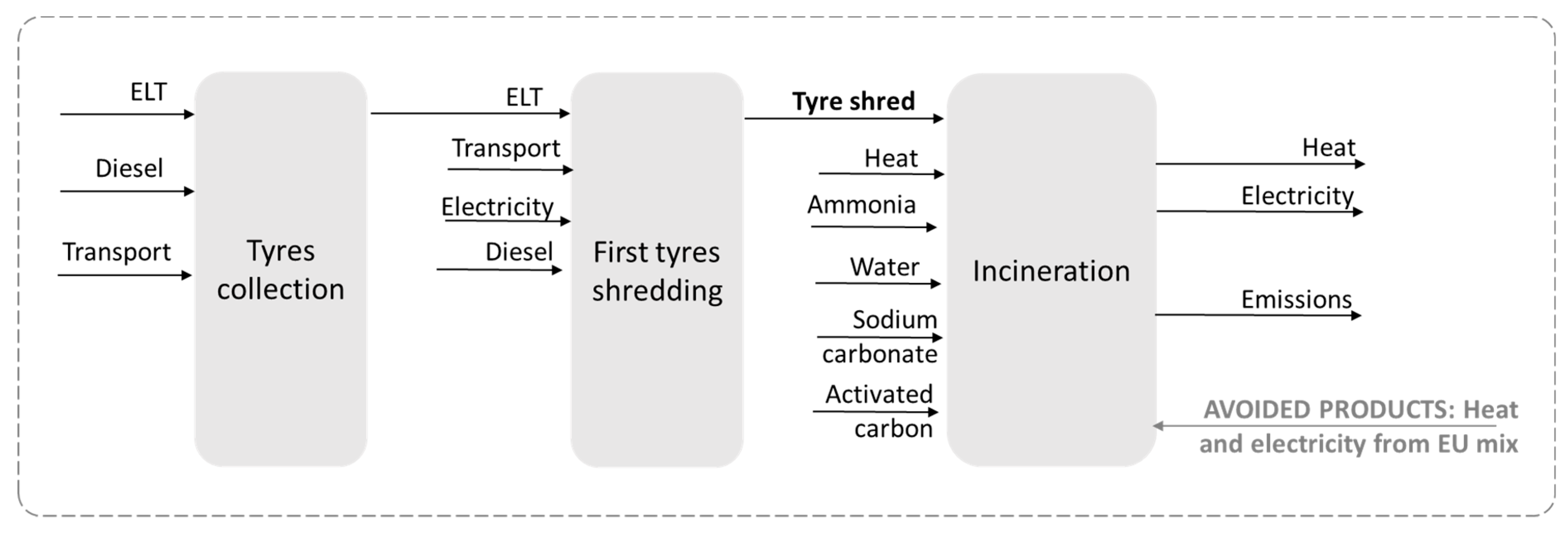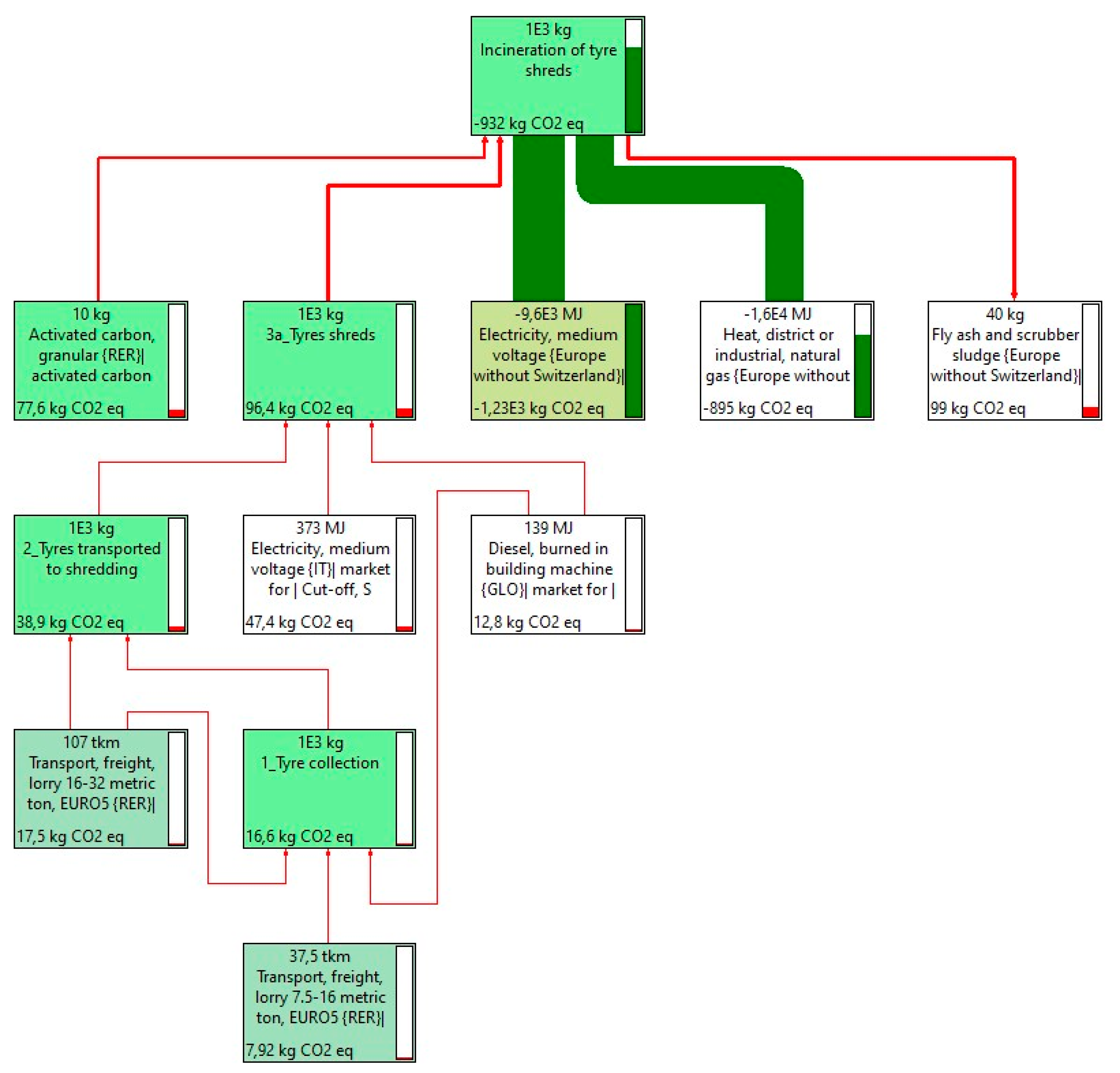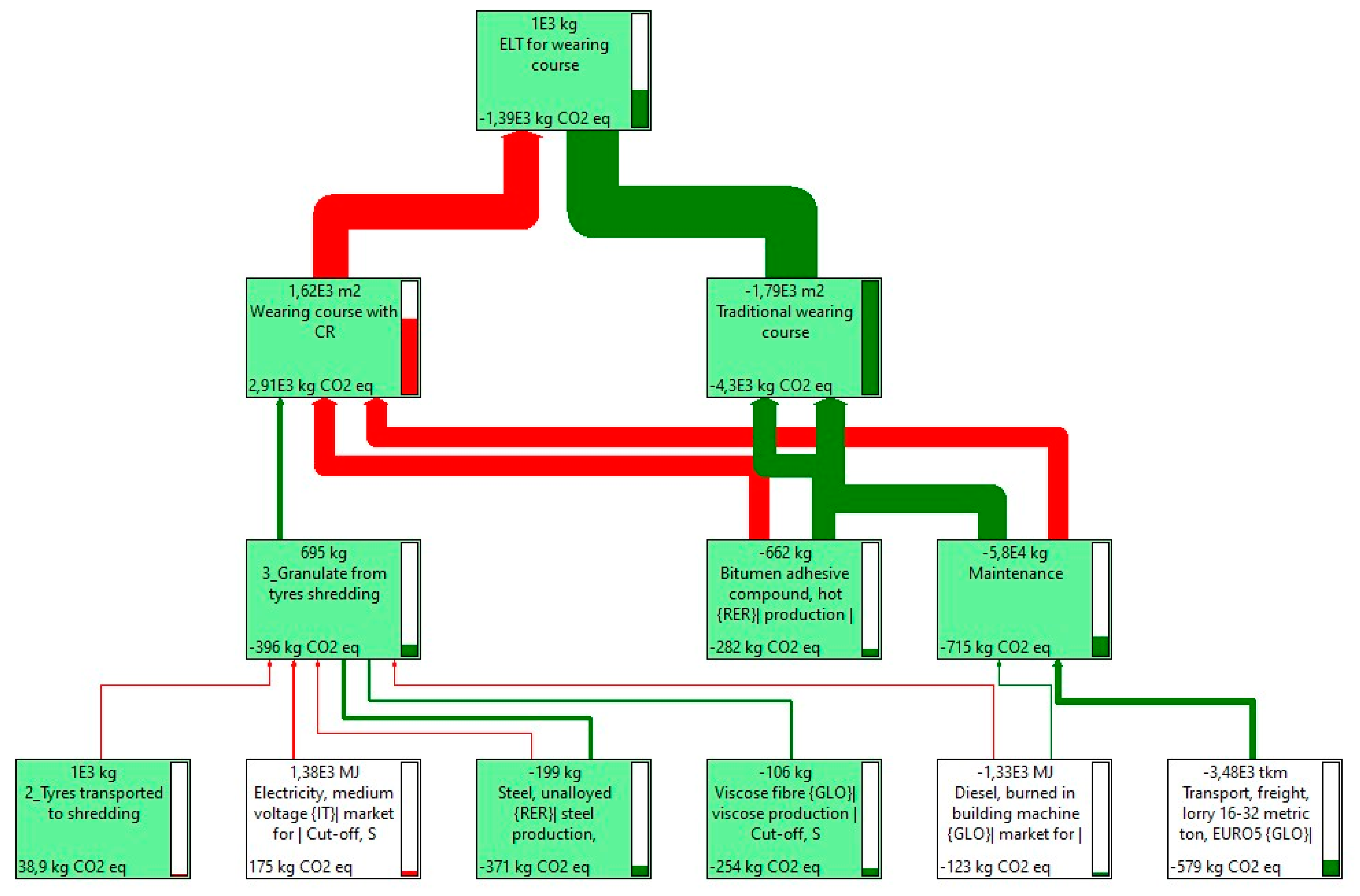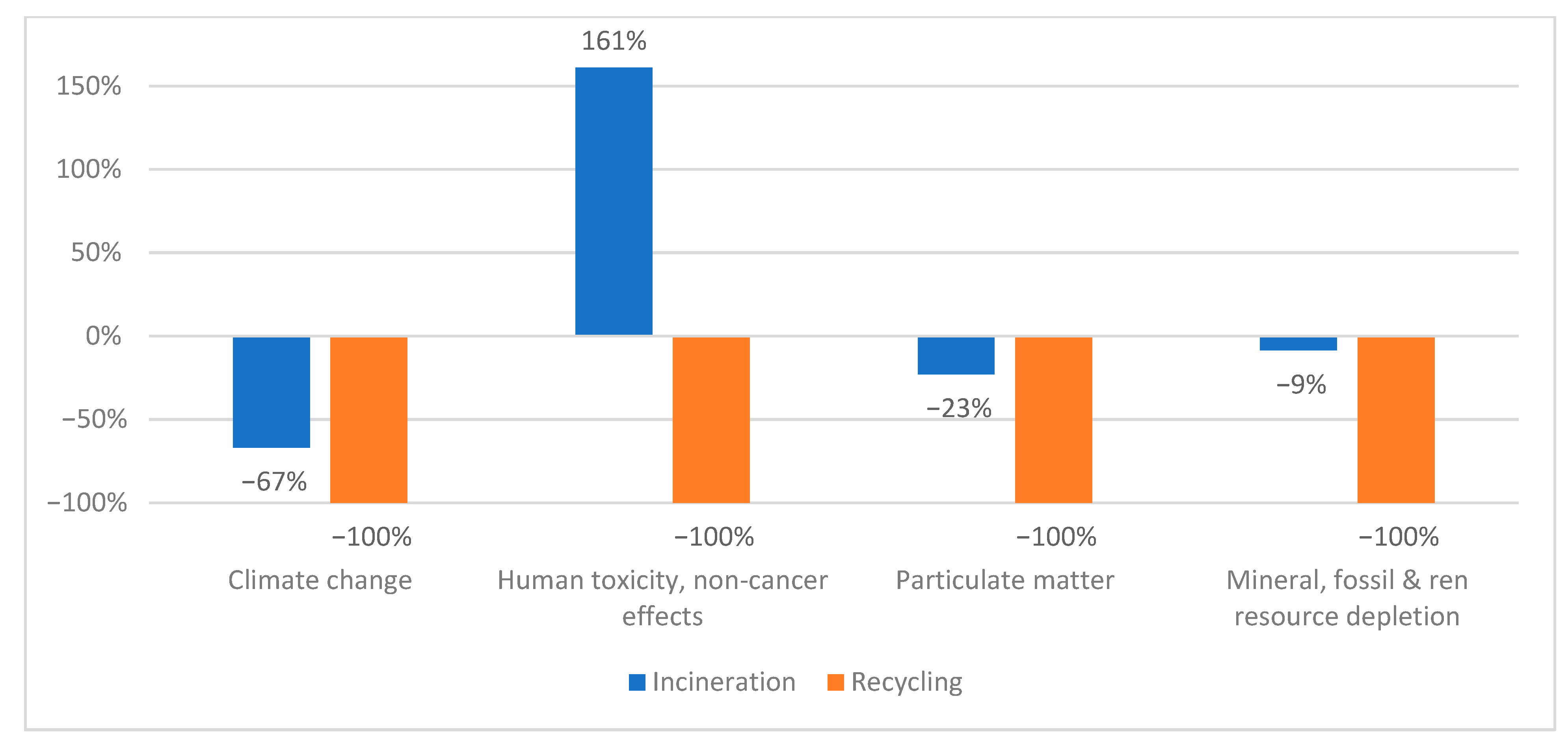End-of-Life Tyres: Comparative Life Cycle Assessment of Treatment Scenarios
Abstract
:Featured Application
Abstract
1. Introduction and State of the Art
2. Materials and Methods
2.1. Analysed Processes
- i
- Collection of ELTs through collection points located throughout the Italian territory;
- ii
- Transportation to crusher plants;
- iii
- First shredding, where the ELT is reduced in pieces from 5 to 40 cm, named “tyre shreds”.
2.2. Goal and Scope
2.3. Life Cycle Inventory
- For the recycling into AR, it is considered the impact of the wearing course construction and the credits given by avoiding the construction of a traditional wearing course. This latter has been calculated according to the inventory provided by Farina et al. [19]. The different lifetime of the two ARs (20 years for the CR waring course and 18 years for the traditional one) has been considered as well.
- For the incineration scenario are considered: (i) the impacts of the incineration process; (ii) the benefits due to the avoided production of electricity and heat through the standard processes.
3. Results
4. Discussion
5. Conclusions
Author Contributions
Funding
Data Availability Statement
Conflicts of Interest
References
- Mashiri, M.S.; Vinod, J.S.; Sheikh, M.N.; Tsang, H.-H. Shear strength and dilatancy behaviour of sand–tyre chip mixtures. Soils Found. 2015, 55, 517–528. [Google Scholar] [CrossRef] [Green Version]
- Mohajerani, A.; Burnett, L.; Smith, J.V.; Markovski, S.; Rodwell, G.; Rahman, M.T.; Kurmus, H.; Mirzababaei, M.; Arulrajah, A.; Horpibulsuk, S.; et al. Recycling waste rubber tyres in construction materials and associated environmental considerations: A review. Resour. Conserv. Recycl. 2020, 155, 104679. [Google Scholar] [CrossRef]
- European Commission. Sustainable Products in a Circular Economy—Towards an EU Product Policy Framework contributing to the Circular Economy; European Commission: Brussels, Belgium, 2019. [Google Scholar]
- Ecopneus. Il Circolo Virtuoso che fa Crescere il Paese; Ecopneus: Milan, Italy, 2019. [Google Scholar]
- The International Standards Organisation Environmental Management—Life Cycle Assessment—Principles and Framework. ISO 14040; ISO: London, UK, 2006; Volume 2006, pp. 1–28. [CrossRef] [Green Version]
- The International Standards Organisation Environmental Management—Life Cycle Assessment—Requirements and Guidelines. ISO 14044; ISO: London, UK, 2006; Volume 2006, pp. 652–668. [CrossRef]
- Blengini, G.A. Applying LCA to organic waste management in Piedmont, Italy. Manag. Environ. Qual. An. Int. J. 2008, 19, 533–549. [Google Scholar] [CrossRef]
- Blengini, G.A.; Fantoni, M.; Busto, M.; Genon, G.; Zanetti, M.C. Participatory approach, acceptability and transparency of waste management LCAs: Case studies of Torino and Cuneo. Waste Manag. 2012, 32, 1712–1721. [Google Scholar] [CrossRef] [PubMed]
- Laurent, A.; Clavreul, J.; Bernstad, A.; Bakas, I.; Niero, M.; Gentil, E.; Christensen, T.H.; Hauschild, M.Z. Review of LCA studies of solid waste management systems–Part II: Methodological guidance for a better practice. Waste Manag. 2014, 34, 589–606. [Google Scholar] [CrossRef] [PubMed]
- Panepinto, D.; Blengini, G.A.; Genon, G. Economic and environmental comparison between two scenarios of waste management: MBT vs. thermal treatment. Resour. Conserv. Recycl. 2015, 97, 16–23. [Google Scholar] [CrossRef]
- Guinée, J.B.; Lindeijer, E. Handbook on Life Cycle Assessment: Operational Guide to the ISO Standards; Springer Science & Business Media: Berlin/Heidelberg, Germany, 2002; Volume 7, ISBN 1402002289. [Google Scholar]
- Clauzade, C.; Osset, P.; Hugrel, C.; Chappert, A.; Durande, M.; Palluau, M. Life cycle assessment of nine recovery methods for end-of-life tyres. Int. J. Life Cycle Assess. 2010, 15, 883–892. [Google Scholar] [CrossRef]
- Fiksel, J.; Bakshi, B.R.; Baral, A.; Guerra, E.; DeQuervain, B. Comparative life cycle assessment of beneficial applications for scrap tires. Clean Technol. Environ. Policy 2011, 13, 19–35. [Google Scholar] [CrossRef]
- Li, X.; Xu, H.; Gao, Y.; Tao, Y. Comparison of end-of-life tire treatment technologies: A Chinese case study. Waste Manag. 2010, 30, 2235–2246. [Google Scholar] [CrossRef]
- Torretta, V.; Rada, E.C.; Ragazzi, M.; Trulli, E.; Istrate, I.A.; Cioca, L.I. Treatment and disposal of tyres: Two EU approaches. A review. Waste Manag. 2015, 45, 152–160. [Google Scholar] [CrossRef]
- Hiba, R.; Emna, B.B.; Hachemi, M. Chahbani Energetic valorization of used tires by pyrolysis: Effect of catalysts on biofuel. MATEC Web Conf. 2020, 307, 1045. [Google Scholar] [CrossRef] [Green Version]
- Anchustegui, P.; Pasakopoulos, E. At the End of the Road: Is There Life after Rolling? Life Cycle Assessment of the Impacts of Different End of Life Treatments of Tyres; Chalmers University of Technology: Göteborg, Sweden, 2019. [Google Scholar]
- Feraldi, R.; Cashman, S.; Huff, M.; Raahauge, L. Comparative LCA of treatment options for US scrap tires: Material recycling and tire-derived fuel combustion. Int. J. Life Cycle Assess. 2013, 18, 613–625. [Google Scholar] [CrossRef]
- Farina, A.; Zanetti, M.C.; Santagata, E.; Blengini, G.A. Life cycle assessment applied to bituminous mixtures containing recycled materials: Crumb rubber and reclaimed asphalt pavement. Resour. Conserv. Recycl. 2017, 117, 204–212. [Google Scholar] [CrossRef]
- Ortiz-Rodriguez, O.; Ocampo-Duque, W.; Duque-Salazar, L. Environmental Impact of End-of-Life Tires: Life Cycle Assessment Comparison of Three Scenarios from a Case Study in Valle Del Cauca, Colombia. Energies 2017, 10, 2117. [Google Scholar] [CrossRef] [Green Version]
- Bressi, S.; Santos, J.; Giunta, M.; Pistonesi, L.; Lo Presti, D. A comparative life-cycle assessment of asphalt mixtures for railway sub-ballast containing alternative materials. Resour. Conserv. Recycl. 2018, 137, 76–88. [Google Scholar] [CrossRef]
- Puccini, M.; Leandri, P.; Tasca, A.L.; Pistonesi, L.; Losa, M. Improving the Environmental Sustainability of Low Noise Pavements: Comparative Life Cycle Assessment of Reclaimed Asphalt and Crumb Rubber Based Warm Mix Technologies. Coatings 2019, 9, 343. [Google Scholar] [CrossRef] [Green Version]
- Wang, T.; Xiao, F.; Zhu, X.; Huang, B.; Wang, J.; Amirkhanian, S. Energy consumption and environmental impact of rubberized asphalt pavement. J. Clean. Prod. 2018, 180, 139–158. [Google Scholar] [CrossRef]
- Yang, X.; You, Z.; Hasan, M.R.M.; Diab, A.; Shao, H.; Chen, S.; Ge, D. Environmental and mechanical performance of crumb rubber modified warm mix asphalt using Evotherm. J. Clean. Prod. 2017, 159, 346–358. [Google Scholar] [CrossRef]
- Zanetti, M.C.; Fiore, S.; Ruffino, B.; Santagata, E.; Dalmazzo, D.; Lanotte, M. Characterization of crumb rubber from end-of-life tyres for paving applications. Waste Manag. 2015, 45, 161–170. [Google Scholar] [CrossRef] [Green Version]
- La Rosa, A.; Recca, G.; Carbone, D.; Battiato, S.; Latteri, A.; Cozzo, G.; Cicala, G. Environmental benefits of using ground tyre rubber in new pneumatic formulations: A life cycle assessment approach. Proc. Inst. Mech. Eng. Part L J. Mater. Des. Appl. 2013. [Google Scholar] [CrossRef]
- Ayoob, A.K.; Fadhil, A.B. Valorization of waste tires in the synthesis of an effective carbon based catalyst for biodiesel production from a mixture of non-edible oils. Fuel 2020, 264, 116754. [Google Scholar] [CrossRef]
- TRM Periodic Measurements. Available online: https://trm.to.it/en/emissions/emissions_regular-withdrawals/ (accessed on 30 March 2021).
- Sharma, V.K.; Fortuna, F.; Mincarini, M.; Berillo, M.; Cornacchia, G. Disposal of waste tyres for energy recovery and safe environment. Appl. Energy 2000, 65, 381–394. [Google Scholar] [CrossRef]






| O. | I | Dataset | Quantity | Unit of Measure |
|---|---|---|---|---|
| Recycling Scenario | ||||
| X | Tyre collected | 1 | t | |
| X | Transport, freight, lorry 7.5–16 metric ton, EURO5 {RER} | 37.5 | tkm | |
| X | Transport, freight, lorry 16–32 metric ton, EURO5 {RER} | 37.5 | tkm | |
| X | Diesel, burned in building machine {GLO}| market for | 28.2 | MJ | |
| X | Tyres transported to shredding | 1 | t | |
| X | Tyre collected | 1 | t | |
| X | Transport, freight, lorry 7.5–16 metric ton, EURO5 {RER} | 9.4 | tkm | |
| X | Transport, freight, lorry 16–32 metric ton, EURO5 {RER} | 69.8 | tkm | |
| X | Transport, freight, lorry >32 metric ton, EURO5 {RER} | 70.6 | tkm | |
| X | Transport, freight, inland waterways, barge tanker {RER}| processing | 0.5 | tkm | |
| X | Granulate from tyres shredding | 695 | kg | |
| X | Avoided product: Steel, unalloyed {RER}| steel production, converter, unalloyed | 199 | kg | |
| X | Avoided product: Viscose fibre {GLO}| viscose production | 106 | kg | |
| X | Tyres transported to shredding | 1 | t | |
| X | Polypropylene, granulate {RER}| production | 1.667 | kg | |
| X | Packaging film, low density polyethylene {RER}| production | 0.185 | kg | |
| X | Transport, freight, lorry 7.5–16 metric ton, EURO5 {RER} | 0.711 | kg | |
| X | Tap water {Europe without Switzerland}| market for | 220 | kg | |
| X | Lubricating oil {RER}| production | 0.04 | kg | |
| X | Polymer foaming {RER}| processing | 0.185 | kg | |
| X | Steel, unalloyed {RER}| steel production, converter, unalloyed | 0.29 | kg | |
| X | Hot rolling, steel {RER}| processing | 0.29 | kg | |
| X | Sheet rolling, steel {RER}| processing | 0.29 | kg | |
| X | Electricity, medium voltage {IT}| market for | 384 | kWh | |
| X | Diesel, burned in building machine {GLO}| market for | 111 | MJ | |
| X | Wearing course with CR | 1 | m2 | |
| X | Natural aggregate | 79.65 | kg | |
| X | Bitumen adhesive compound, hot {RER}| production | 2.41 | kg | |
| X | Granulate from tyres shredding | 0.43 | kg | |
| X | Diesel, burned in building machine {GLO}| market for | 2.09 | MJ | |
| X | Transport, freight, lorry 16–32 metric ton, EURO5 {GLO}| market for | 4948 | kgkm | |
| X | Avoided product: Standard wearing course | 1 | m2 | |
| X | Natural aggregate | 104.1 | kg | |
| X | Bitumen adhesive compound, hot {RER}| production | 2.54 | kg | |
| X | Diesel, burned in building machine {GLO}| market for | 2.70 | MJ | |
| X | Transport, freight, lorry 16–32 metric ton, EURO5 {GLO}| market for | 6398 | kgkm | |
| Energy Recovery Scenario | ||||
| X | Tyre collected | 1 | t | |
| X | Transport, freight, lorry 7.5–16 metric ton, EURO5 {RER} | 37.5 | tkm | |
| X | Transport, freight, lorry 16–32 metric ton, EURO5 {RER} | 37.5 | tkm | |
| X | Diesel, burned in building machine {GLO}| market for | 28.2 | MJ | |
| X | Tyres transported to shredding | 1 | t | |
| X | Tyre collected | 1 | t | |
| X | Transport, freight, lorry 7.5–16 metric ton, EURO5 {RER} | 9.4 | tkm | |
| X | Transport, freight, lorry 16–32 metric ton, EURO5 {RER} | 69.8 | tkm | |
| X | Transport, freight, lorry >32 metric ton, EURO5 {RER} | 70.6 | tkm | |
| X | Transport, freight, inland waterways, barge tanker {RER}| processing | 0.5 | tkm | |
| X | Tyres shred | 1 | t | |
| X | Tyres transported to shredding | 1 | t | |
| X | Electricity, medium voltage {IT}| market for | Cut-off, S | 104 | kWh | |
| X | Diesel, burned in building machine {GLO}| market for | 111 | MJ | |
| X | Electricity | 9.6 | MJ | |
| X | Heat | 16 | MJ | |
| X | Tap water {Europe without Switzerland}| market for | 1.77 | kg | |
| X | Ammonia, liquid {RER}| market for | 0.003 | kg | |
| X | Activated carbon, granular {RER}| activated carbon production, granular from hard coal | 0.001 | kg | |
| X | Granulate from tyres shredding | 1 | kg | |
| X | Heat, district or industrial, natural gas {RER}| market group for | 0.103 | MJ | |
| X | Emission in air: Carbon dioxide | 0.9 | kg | |
| X | Emission in air: Ammonia | 3.25 | mg | |
| X | Emission in air: Antimony | 3.25 | mg | |
| X | Emission in air: Arsenic | 3.25 | mg | |
| X | Emission in air: Cadmium | 3.25 | mg | |
| X | Emission in air: Cobalt | 3.25 | mg | |
| X | Emission in air: Chromium VI | 3.25 | mg | |
| X | Emission in air: Dioxins (TEQ) | 0.65 | ng | |
| X | Emission in air: Polycyclic organic matter, unspecified | 0.65 | mg | |
| X | Emission in air: Manganese | 3.25 | mg | |
| X | Emission in air: Mercury | 0.325 | mg | |
| X | Emission in air: Carbon monoxide | 325 | mg | |
| X | Emission in air: Nickel | 3.25 | mg | |
| X | Emission in air: Nitrogen oxides | 1.3 | g | |
| X | Emission in air: Sulfur oxides | 325 | mg | |
| X | Emission in air: Particulates, unspecified | 65 | mg | |
| X | Emission in air: Zinc | 3.25 | mg | |
| X | Emission in air: Hydrogen chloride | 65 | mg | |
| X | Emission in air: Hydrogen fluoride | 6.5 | mg | |
| X | Fly ash and scrubber sludge {Europe without Switzerland}| market for fly ash and scrubber sludge | 0.04 | kg | |
| X | Hard coal ash {CH}| treatment of, municipal incineration | 0.15 | kg | |
| Impact Category (Method: ILCD Midpoint) | Unit | Incineration Scenario | Recycling Scenario |
|---|---|---|---|
| Climate change | kg CO2 eq | −9.32 × 102 | −1.39 × 103 |
| Ozone depletion | kg CFC-11 eq | −2.14 × 10−4 | −6.04 × 10−4 |
| Human toxicity, non-cancer effects | CTUh | 7.03 × 10−4 | −4.37 × 10−4 |
| Human toxicity, cancer effects | CTUh | −5.70 × 10−5 | −1.32 × 10−4 |
| Particulate matter | kg PM2.5 eq | −3.53 × 10−1 | −1.54 |
| Ionizing radiation HH | kBq U235 eq | −5.96 × 102 | −2.10 × 102 |
| Ionizing radiation E (interim) | CTUe | −1.38 × 10−3 | −1.38 × 10−3 |
| Photochemical ozone formation | kg NMVOC eq | −1.09 | −8.92 |
| Acidification | molc H+ eq | −5.72 | −1.06 × 101 |
| Terrestrial eutrophication | molc N eq | −6.98 | −2.14 × 101 |
| Freshwater eutrophication | kg P eq | −1.11 | −3.83 × 10−1 |
| Marine eutrophication | kg N eq | −5.22 × 10−1 | −2.18 |
| Freshwater ecotoxicity | CTUe | −4.73 × 103 | −8.87 × 103 |
| Land use | kg C deficit | −6.47 × 102 | −9.13 × 103 |
| Water resource depletion | m3 water eq | −7.77 | 9.46 × 10−1 |
| Mineral, fossil & ren resource depletion | kg Sb eq | −6.62 × 10−3 | −7.71 × 10−2 |
Publisher’s Note: MDPI stays neutral with regard to jurisdictional claims in published maps and institutional affiliations. |
© 2021 by the authors. Licensee MDPI, Basel, Switzerland. This article is an open access article distributed under the terms and conditions of the Creative Commons Attribution (CC BY) license (https://creativecommons.org/licenses/by/4.0/).
Share and Cite
Bianco, I.; Panepinto, D.; Zanetti, M. End-of-Life Tyres: Comparative Life Cycle Assessment of Treatment Scenarios. Appl. Sci. 2021, 11, 3599. https://doi.org/10.3390/app11083599
Bianco I, Panepinto D, Zanetti M. End-of-Life Tyres: Comparative Life Cycle Assessment of Treatment Scenarios. Applied Sciences. 2021; 11(8):3599. https://doi.org/10.3390/app11083599
Chicago/Turabian StyleBianco, Isabella, Deborah Panepinto, and Mariachiara Zanetti. 2021. "End-of-Life Tyres: Comparative Life Cycle Assessment of Treatment Scenarios" Applied Sciences 11, no. 8: 3599. https://doi.org/10.3390/app11083599






